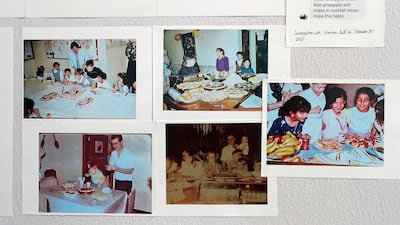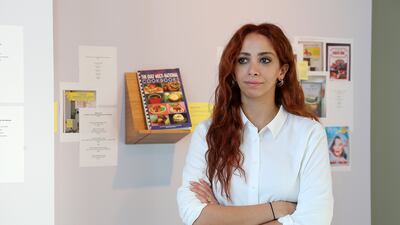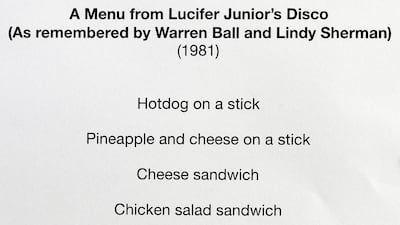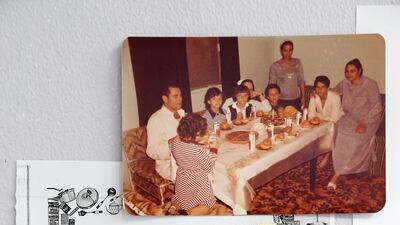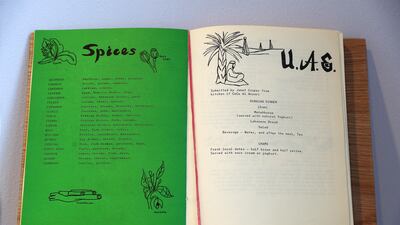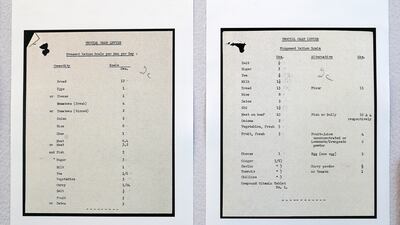When HS, an Egyptian, arrived in the UAE in the early 1970s, she has a vivid recollection of being served the fuala tray when visiting local homes.
“We used to find it strange because it had everything from A to Z … from all traditions. It had pistachio and radish, nuts and raisins, something baked called gebab or chebab … It had Indian and Pakistani food, it had what they picked up from Egyptian cuisine or what they knew from the Lebanese,” HS said in an audio interview in 2017.
HS is no longer alive, but her voice and the transcript of her culinary recollections are part of a new exhibition titled Menus of Dubai, ongoing at the Jameel Arts Centre until August. The exhibition explores the interconnection between food, culture, history, politics and economies while looking at the lives of migrant communities in Dubai. It’s been curated by Salma Serry, a food researcher and filmmaker from the UAE.
Serry’s research includes printed restaurant menus, community cookbooks, personal photos, interviews and television cookery shows from the late 1960s to the end of the 1990s. In doing so, she has constructed archival material that pays homage to an often-overlooked regional narrative.
food researcher
“I reapproached the construct of a menu, to include home-cooked meals, school and office lunches, birthday cakes and oral recipes to document the unofficial heritage of various migrant communities. From a larger perspective, it is an attempt to make sense of today by looking at the past,” says Serry, who is a fourth-generation Egyptian immigrant.
Through her research, she wanted to bring forth the unheard voices of migrant communities and explore how food shapes the intermingling of cultures.
“If you look at the fuala tray itself, I was unaware of this custom before I spoke to the lady. Along with the interview, she also chronicles the evolution of the tray, from first being a mixture of odd eatables available at home, to [including] the more Emirati balaleet, then somethings from other cultures, and slowly even gateaux, sweets and ice cream.
“She also talks about disliking Indian basmati rice at first and then getting so used to it, she would cook it even when she would travel to Egypt,” says Serry. “For me, she is a perfect example of an expat who came and lived here for so many years and then disappeared. Through my work, I wanted to give these people a voice. Certain communities may not be part of the official discourse, but they existed.”
Other segments of the exhibition include a daily food ration list distributed among soldiers in the Trucial Oman Levies of 1953, and conversations between students about their school lunches from 1960 to 1980 (an Indian High School student shares details of a home-cooked packed meal of puri bhaji, koki, dal pakwan, nuts and fruit; while an Al Muhallab Boys School student would get a samoun, processed cheese triangles, jam, fruit and milk or juice).

Elsewhere, office lunch menus lie on display; one from Japanese restaurant Bento-ya and a thali menu from the now-shuttered Sadhana Indian restaurant.
Serry says she stumbled upon various interesting discoveries about the UAE while researching these myriad menus.
“In the 1970s, people mostly ate frozen and canned food. With time, as the migrant population wanted to recreate the food they had at home, there was a need to bring in fresh produce, and also spices and condiments from adjoining countries. This need for regional food fuelled an increase in trade and led to an economic boom,” she says.
Roaming bakery vans were also all the rage a few decades ago – mainly Golden Loaf and Modern Bakery that frequented the Karama, Bur Dubai, Deira and Jumeirah areas. “It would have been snack time for kids, to buy little treats with their pocket money,” says Serry.
Another section is dedicated to the birthday parties of middle-class migrants. The majority of interviewees share they made a trip to Spinney’s to buy birthday cakes.
“To me, it showed a certain colonial hierarchy of food and supermarkets. As most migrants lived away from their families, it was also an insight into how birthday-party invites to neighbours and friends would have been a hotbed for cultural and social exchange,” says Serry.

This inquisitiveness about food and its cultural connotations date back to the researcher’s own childhood, as she recollects receiving her first cookbook at the age of 7. By the time she was 11, she had created her own recipe book with food stickers. One of the recipes, dedicated to her best friend, was a fruit cream concoction made out of canned fruits and Nestle cream.
After completing a master’s degree in television and digital journalism from the American University of Cairo, Serry was compelled to branch out into researching cultural culinary roots a few years ago.
“I was asked about my own food history and, strangely, as I spoke about Egyptian food and heritage, I realised that it is not an authentic representation. I grew up in the UAE, so the food I ate was a mixture and influenced by many other factors. So my migrant food narrative is complicated,” she explains.
Serry is currently pursuing a master’s in gastronomy at Boston University, where she is researching the food histories of the South-west Asia and North Africa (SWANA) region. She is also the founder of @sufra_kitchen on Instagram.
Over the years, she has amassed a collection of more than 400 historical cookbooks and was recently awarded the Arab Fund for Art and Culture grant for her ongoing research on the modern history of food in SWANA. A manuscript is also on the cards.
In a forthcoming research paper, Serry will look at the widely popular cafeteria culture in the Emirates, alongside the issues of luxury, kitsch and identity politics in Dubai. Serry points out that although these cafes dish out low-income migrant food, they have become part of the local Emirati food culture with a luxurious and nationalistic branding.
“You see people whizzing past these cafeterias in their four-wheel drives for karak tea and parottas. Even the names of their dishes – Arbab Burger, Rolex Cocktail, Lexus Shake – are great examples of the intermingled ways that one finds in both the immigrant and the indigenous societies of Dubai.”
Menus of Dubai by Salma Serry is ongoing as part of Jameel Arts Centre’s Library Circles until August 1
